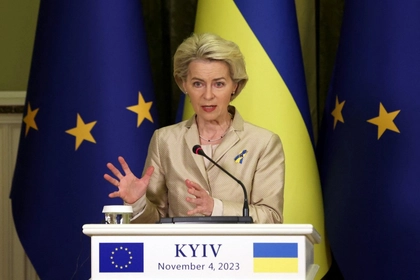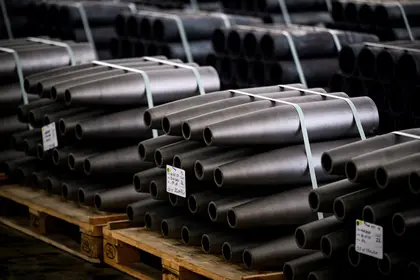The war in Ukraine has evolved considerably since Russia annexed Crimea in 2014, and the tempo has accelerated. A low-intensity conflict became a full-scale assault. An attempted “blitzkrieg” in February 2022 morphed into a protracted war. Russian military power has since been reduced and it has become the second-strongest army fighting in Ukraine.
Russia has now lost the military initiative while Ukraine has benefited from increasingly more advanced weapons systems and developed its own strike capabilities. What we also now see is a war of drones – a war unlike anything the world has ever experienced.
JOIN US ON TELEGRAM
Follow our coverage of the war on the @Kyivpost_official.
Russia’s playbook for undermining Ukraine and the West
The process looks set to remain dynamic as the initial effect of Western sanctions on Russia starts to wane. The Kremlin is succeeding in circumventing many of the sanctions introduced to destroy its ability to wage war. Additionally, China, Iran and North Korea’s military support to Russia might develop further.
Russia is now employing a whole host of tools – military and non-military– to undermine Ukraine, as well as international cohesion. It continues to weaken Western democracies, slowly changing the political landscape in Europe to its own benefit.
Russia is still pounding Ukrainian cities and infrastructure from the air. Having improved its national drone production capacity, it is also building a stockpile of long-range missiles in preparation for winter and an expected renewed campaign against the Ukrainian energy sector. Russia is not only aiming to exacerbate the humanitarian crisis, but also further undermine Ukraine’s economic foundation.

EU Transfers €1.5 Bln Raised From Russian Assets for Ukraine
The maritime blockade of Ukrainian ports is still effective. Even though five civilian vessels have successfully transited the temporarily established ship traffic corridor, the great majority of Ukrainian exports and imports are limited to roads and railways that are not fit for purpose. Russia’s ongoing campaign to destroy Ukraine’s ports and associated infrastructure supports its broader efforts.
Russia’s warfare not only continues to cause massive suffering and damage but has also rendered Ukraine fundamentally dependent upon international financial and humanitarian support to survive.
Importance of continued and proactive support for Ukraine
It is now crucial that proactive support for Ukraine reflects the evolving situation so that Ukraine maintains the initiative. This support must not only close existing vulnerabilities but also ensure future improvements.
Future Western support will likely be constrained by existing stockpiles and inherent limitations of the US and European defense industries. While aiming to ramp up production, a substantial increase is not likely in the short-term.
There are also some strategic realities to factor in. As with the first years of World War II, there is limited political will in the West to do what is needed. In the case of Ukraine, that means intervening militarily and/or inviting Ukraine to become a NATO member. That will only happen when all diplomatic options have been exhausted, and when the scale and scope of the war, including its increasingly more severe consequences, are fully recognised.
Support needs to reflect Ukraine’s enduring needs. The West must uphold Ukraine’s request for ammunition, long-range fire, air defense, combat aircraft, heavy weapons and, not least, mine clearance systems.
Meeting the challenges of the “war of drones”
The international community must mobilize industry to meet the new challenges of the war of drones. It must increase production and delivery of all kinds of Unmanned Aerial Vehicles (UAVs), including those used for strikes, intelligence, surveillance and reconnaissance (ISR); as well as search and rescue. Ukraine’s international partners must help Ukraine to develop drones for air defense, mine detection and transportation, such as medical aid.
Kamikaze drones should be prioritized. Based on Ukrainian reports, they might be responsible for around 25 percent of Russian losses. Such increased capability will compensate for the limited inflow of artillery shells, as well as increasing Ukraine’s overall ability to inflict damage. It will enable an even more effective hunt for Russian heavy weapons, including artillery, Multiple Launch Rocket Systems (MLRS) and air defense systems protecting the minefields and trenches. It will further improve its ability to undermine its logistics system and its command-and-control nodes.
Russia is allegedly producing far more UAVs than Ukraine. According to Ukrainian military volunteer and women's rights advocate Maria Berlinska, Ukrainian manufacturers currently fall short of producing 10,000 quality First Person View (FPV) drones per month. Meanwhile, the Russians have already reached a monthly output of 45,000-50,000 drones. Ukraine urgently needs more counter-drone systems to both close existing capability gaps but also meet future security challenges.
Gaining the advantage
The side that succeeds in ramping up its production of drones and associated countermeasures will be able to fundamentally change the situation on the battlefield.
Acknowledging that the West will not have boots on the ground any time soon, the US and Europe must provide long-range weapons to Ukraine capable of both destroying the Russian logistical system in the deep rear, as well as its ground line of communication. Destroying the bridges from Crimea to mainland Russia and Ukraine is a matter of priority to help reduce Russia’s ability to inflict damage and undermine the morale and motivation of its soldiers.
The West must also walk back on its restriction on attacking legitimate military targets on Russian territory.
As of now, Russia has deployed 46 launchers of the Iskander mobile short-range ballistic missile system along the border of Ukraine. It is used to attacking Ukrainian cities and infrastructure. Presently, only the Patriot air defense system can down the missiles, leaving most Ukrainian cities vulnerable. Ukraine therefore urgently needs the capacity and freedom to target the launchers before the ballistic and R-500 cruise missiles (“Iskander-K”) are launched.
The Iskander launchers are, however, only one out of many weapons systems used to attack Ukrainian civilians, industry and infrastructure from Russian territory. All need to be targeted.
Equally important, Ukraine should be allowed to target the Russian defense industry which is sustaining the Kremlin’s war of aggression. Meanwhile, the West needs to accept that sanctions are no longer able to fundamentally change Russia’s will to wage war.
Wake-up call for training
The US and Europe have so far trained around 63,000 Ukrainian soldiers and delivered the training support requested by Ukraine. Given the lessons learned from the first phase of training, however, one commander (as one of many examples) argues that he would be dead had he fought exactly how the US and its allies taught him. The overall feedback is that instructors do not fully grasp the situation along the frontline in Ukraine; furthermore, NATO training standards do not fully meet the requirements of modern, high-intensity warfare.
I would recommend a better fusion between the Ukrainian experience and Western training capacity. Future training should include embedded Ukrainian personnel, ensuring both increased relevance as well as a more seamless transfer of knowledge and experience between NATO and Ukraine. An increase in time available for training should also be considered.
The Armed Forces of Ukraine (AFU) must help qualify NATO member states for a possible war with the Russian Federation. This will both improve the level of training, as well as improve NATO deterrence.
Helping Ukraine defeat Russia on land will not, however, secure a Ukrainian victory. International support must help Ukraine counter Russia in the air, at sea, and in the non-military sphere.
Freedom of Navigation Operation in the Black Sea
Ukraine will likely lack the capability to break the maritime blockade for years to come. While its drones and missiles allow it to conduct Sea Denial operations, they will not enable sea control and protection of shipping. NATO – or more likely, a coalition of the willing – should therefore consider establishing a Freedom of Navigation Operation in the Black Sea (FONOPS).
While acknowledging the risks involved in operating close to an aggressor at war, a FONOPS in the Black Sea is not fundamentally different from a similar operation in the Arctic or the South China Sea. It is first about upholding the universal freedom of navigation crucial for the global economy. It would, however, also demonstrate Western resolve as a first step to force Russia to step back from its aggressive foreign policy. It might not least, help Ukraine survive economically.
The West must also increase its focus on medical support and psychological rehabilitation. This is not only a question of saving lives but, ultimately, improving Ukraine’s ability to recruit and sustain operations. As it prepares for a protracted war, its ability to support the physical and mental casualties of war becomes increasingly more important. Suicide prevention hot lines report a three-to-four-fold increase in calls.
The international community must also gear up its efforts to help repair military equipment and restore the combat capability of military units. Having demonstrated its superior survivability in battle – and acknowledging limited US willingness to provide heavy weapons – Ukraine can only sustain its offensive if its ability to recover damaged material is improved.
Strategic narrative needs to change
Lastly, and acknowledging the lack political will to deploy Western “boots on the ground” and NATO’s sustainability problems – but also Western determination to ensure that Russia fails in Ukraine – I would strongly encourage a change of strategic narrative.
The Western strategic narrative that what’s happening in Ukraine is “Russia-Ukraine war” is true. It is, however, only a part of the truth.
It has always been a broader confrontation between Russia and the West. To ensure continued support to Ukraine – and essentially defense of European security and stability – the full scale and scope of the war must be explained to the public. Objective facts will mobilize the support needed to uphold and potentially increase the present level of defense, humanitarian, and financial support in the years to come.
Only the truth – and nothing but the truth – will help us to prepare for a war that continues to evolve and escalate. Western support must not only continue to evolve but also help Ukraine maintain the initiative.
Hans Petter Midttun, Independent Analyst, Hybrid Warfare; Non-resident Fellow at the Center for Defense Strategies; board member of the Ukrainian Institute for Security and Law of the Sea; former Defense Attaché of Norway to Ukraine, and Officer (R) of the Norwegian Armed Forces.
The views expressed are the author’s and not necessarily of Kyiv Post.
You can also highlight the text and press Ctrl + Enter






